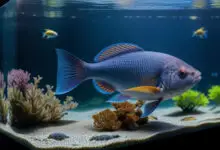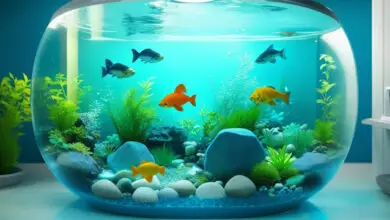Keeping Tanks Crystal Clear: How Protein Skimmers Help Remove Waste

One of the keys to maintaining a healthy, thriving aquarium is providing pristine water quality. Allowing dissolved organic compounds and proteins from fish waste, uneaten food, and decomposing plants to build up causes major issues. Using a protein skimmer is one of the best ways to export these substances helping ensure clean tank water to support aquatic life. This article explains what protein skimmers do, why they are useful, how to select the right one, proper setup, maintenance and maximizing their waste-eliminating benefits.
What is a Protein Skimmer?
A protein skimmer (also called foam fractionator or foam splitter) is a water filtration device used most often in saltwater systems. It removes organic waste like proteins, food particles and fish waste before they break down further. Inside the main skimming chamber, air bubbles are injected creating turbulence. This causes proteins to form microscopic bubbles that rise carrying waste up to a collection cup for removal. Less dissolved organics results in clearer water with lowered nutrient levels.
Why Use One on Your Aquarium?
There are several excellent reasons to utilize a protein skimmer to improve water conditions, including:
- Removes dissolved organic compounds (DOC’s) before breakdown
- Exports proteins, bacteria and fine debris improving clarity
- Lowers nitrate by exporting waste prior to processing
- Reduces required water changes less disrupting tank stability
- Helps maintain appropriate pH levels
- Generally supports improved fish health environments
By continually stripping proteins and carbon-rich substances out early, less waste accumulates for filters and bacteria to continually have to process. This creates a cleaner, healthier tank.
Types of Protein Skimmers
Many design varieties exist but most fit into two main bucket categories:
1. Air Stone Protein Skimmers
Often called venturi skimmers, these feature an air stone that injects microbubbles into a mixing chamber. Water gets sucked up a tube where turbulence causes foam carrying proteins up a smaller tube into a collection cup. They generally sit horizontally in sumps. These simplest models are least expensive but usually least efficient for waste removal too.
2. Needle Wheel Protein Skimmers
In needle wheel models, a rapidly spinning wheel chops up air into thousands of microbubbles which enter a column mixing chamber. The violent churning causes proteins to outgas better adhering to bubbles lifting foam upwards where it overflows into the collection container. More costly, needle wheels require special pumps yet pull out higher amounts of dissolved organics. These work well in media reactor chambers.
Skimmer Selection Considerations
Choosing an appropriately-sized quality protein skimmer suited to your tank ensures the best organic waste removal. When selecting a skimmer, key aspects to consider include:
- Aquarium size & gallon amounts – Match skimmer capacity ratings to tank volume for best operation.
- Water flow processing rate – Look for rated flow gallons per hour (gph) that well-exceeds tank volume for full water processing.
- Skimming method type – Pick air stone, needle wheel or spiral variant that fits your tank goals and price range.
- Footprint dimensions – Confirm unit has small enough footprint to fit comfortably inside sump or display.
- Height & collection cup size – Ensure adequate height and cup volume capacity to prevent overflow mess.
Selecting the right specification model for your tank ensures suitable dissolving capacity for waste concentrations present.
How Do Protein Skimmers Actually Work?
Understanding the science behind the inner workings of these units helps ensure you utilize them optimally:
Air Injection – Air stones or needle wheels first chop air into thousands of superfine bubbles.
Contact Chamber – These microbubbles get injected under pressure into a mixing chamber filled with aquarium water.
Bubble Turbulence – The churning bubbles adhere to proteins and carry them upwards towards the surface.
Surface Tension – At the water line, bubbles pop concentrating organics in a floating foam layer that flows into the collection container above.
Optimizing contact time and bubble density removes more dissolved compounds for higher water purity.
Ideal Protein Skimmer Setup Tips
Properly installing your protein skimmer allows it to remove the most gunk for the cleanest water possible:
- Position it prior to mechanical filtration like filter socks or pads to prevent excessive debris clogging
- Ensure adequate height for rated water flow levels to create needed foam fractionation
- Keep stable and upright with consistent water volumes flowing in
- Use controllable water pumps allowing flow rate adjustment
- Site it away from excessive vibration that could impede finer skimming balance
Take time initially adjusting air and water flows to tune for the thickest stable foam fraction for highest export of unwanted compounds in your tank conditions.
Protein Skimmer Maintenance
With any highly-effective aquarium filter device, periodic cleaning and care is essential for maintaining normal operation. Follow this maintenance regimen for keeping protein skimmers doing their best organic removing work:
Daily: Quickly inspect unit is running properly with steady streams of foamy bubbles rising smoothly.
Weekly: Wipe down collection cup removing surface film and residue preventing overflow back into tank. Rinse cup only using tank water to preserve balanced bacteria levels.
Monthly: Soak disassemble and clean air silencer, venturi nozzles or needlewheels with vinegar or citric acid solution to reduce mineral buildup clogging small orifices. Rinse well before reattaching.
Yearly: Empty entire skimming chamber and use dilute bleach or peroxide solution to dissolve organics and oxidize surfaces preventing future growths that could restrict function. Rinse extremely thoroughly afterwards and allow 1-2 weeks to repopulate bacteria essential for the skimming process.
Staying on top of cleaning schedules based on your tank’s waste production levels keeps the skimmer doing its fizzy bubble water clarifying job long-term.
Skimmer Break-In Periods
Brand new out-of-the-box protein skimmers require a “break-in” period when first installed before reaching peak dissolved organic compound removing performance. These steps help complete the break-in fast so full waste eliminating benefits start quicker:
- Operate new skimmer on a bucket of water for 24 hours allowing components to wear-in
- Start tank operation with low bioload by not overstocking livestock initially
- Adjust air and water flows in small increments allowing stabilization for at least 1 hour before further tuning
- Control foam levels not allowing collection cup to overflow back into tank
- Test operation at least weekly gradually dialing-in flows for ideal thick foam
- Run unit consistently allowing prime biofilms essential for skimming process to fully develop
Usually after 2-6 weeks of controlled break-in, the skimmer reaches a mature operational equilibrium removing the highest amounts of proteins consistently keeping water clear.
Maximizing Protein Skimming Efficiency
Optimizing the performance of your aquarium protein skimmer means tightly monitoring various configuration settings and inputs for peak operation:
Water Flow Rate – Adjust feed water volumes entering the unit until rated turnover capacity is reached based on tank size. Increased flow generally equals more air bubbles and improved protein contact.
Air Flow Levels – Tune air stones or needlewheels to produce a fine, condensed foam not allowing collection cup overflow which reintroduces organics. Too little air flow limits bubble turbulence contact.
Water Line Height – Having correct water volumes reaching ideal mid-level exit nozzles fosters the most vigorous mixing for floating foam. Double check manufacturer fill guidelines.
Bioload Counts – Start with conservative livestock totals during initial break-in period allowing the bio-skimming process to adapt and stabilize removing increasing waste amounts over time.
Pay close attention to all operational parameters and make small gradual tuning changes to maximize dissolution of pesky organics floating around tanks for that spectacular crystal clear aquatic viewing!
Ideal Tank Locations
Choosing the right installation location allows a protein skimmer to work at peak cleaning capacity:
Display Tank – Smaller units can mount directly inside main tank if space allows. Ensure good bubble diffusion paths.
Sump Chamber – Larger skimmers usually position inside sumps allowing huge volumes passing through.
Media Reactor – Needle wheel variants fit nicely pulling water from input line then returning outlet into reactors harboring cleansing resins.
Dedicated Skimmer Box – Some systems utilize a standalone housing unit just for the skimmer allowing completely optimized flows.
Keep the unit protected from debris accumulation while properly oxygenating output water before returning to prevent any gas bubble risks to inhabitants.
Using Ozone with Skimmers
Combining ozone gas injection with protein skimming combines two powerful filtration processes creating a one-two punch battling dissolved organic waste:
Ozone Benefits
- Oxidizes difficult yellowing organic compounds cleared by skimming
- Reduces nitrates not exported initially
- Kills bacteria increasing bio-security
- Enhances oxygenation aiding fish health
Joint Operation
- Inject ozone gas into bubble contact chamber significantly improving protein oxidation removal
- Diffuse off-gas allowing ozone to degrade before water returns to tank
- Start with low ozone concentrations to avoid toxicity issues
The duo of foam fractionation and ozonation works hand-in-hand limiting buildup of yellowing carbon-rich materials that degrade aquatic life quality and spark algae blooms.
Troubleshooting Guide
Like any complex filtration device, issues can arise with protein skimmers that reduce their waste removing effectiveness. Try these troubleshooting tips if your unit seems underperforming:
Problem: Foam production drops off or water level rises in cup
Fix: Clean collection cup then adjust air stone/needlewheel and pump output flow rates in 5-10% increments allowing to re-stabilize for at least 1 hour between.
Problem: No change in foam bubbles or thickness despite flow adjustments
Fix: Take apart and soak/scrub air stone nozzle, needlewheel and column tubes in citric acid solution to remove mineral buildup or organic film clogs.
Problem: Loud noises emanating from within unit
Fix: Disassemble to lubricate impeller shafts, inspect needlewheels for obstructions, and re-seat air stone or nozzles to prevent vibration issues.
Don’t let your skimmer issues go unresolved for long. Properly cleaning and tuning flows returns full functionality reducing organic waste for a thriving underwater world.
Final Thoughts
Installing and optimizing a protein skimmer can take patience getting the right settings tuned for your tank conditions and inhabitants. However, once fully operational after an initial break-in period, these devices continually pull impressive amounts of troublesome dissolved organic compounds out before they break down polluting closed aquarium systems. This aids mechanical filters, reduces overall waste, and improves aesthetics. For both fresh and saltwater setups, add one of these units for higher oxygenation and exporting excess proteins for that crystal clear water clarity making aquatic life really sparkle!







